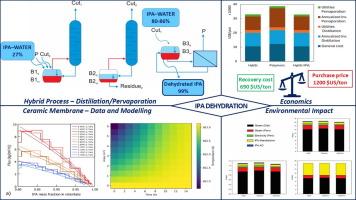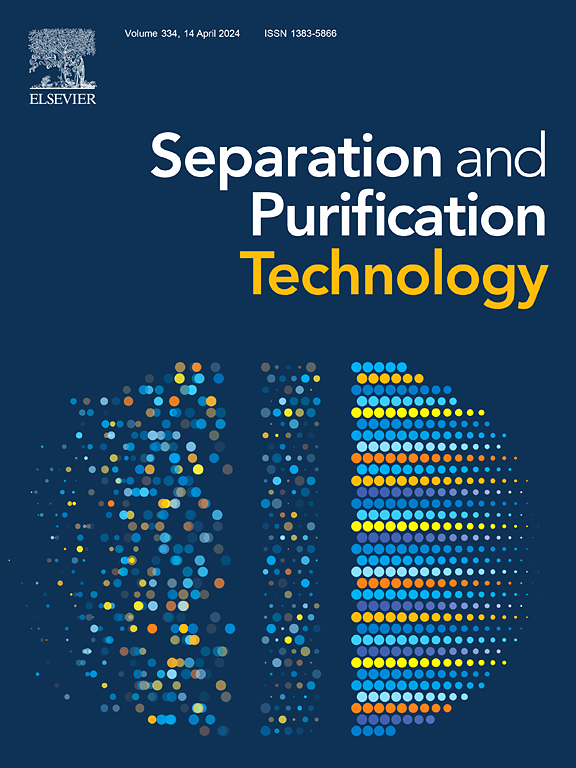Variants of the hybrid distillation/pervaporation process: Conceptual model-based optimization and environmental analysis for IPA dehydration
IF 8.1
1区 工程技术
Q1 ENGINEERING, CHEMICAL
引用次数: 0
Abstract
Applied to IPA dehydration, this paper analyses the economic and environmental performance of two variants of the hybrid distillation/pervaporation process operated in batch wise mode; namely, distillation followed by pervaporation with either a polymeric membrane or a ceramic membrane. Both variants are also compared from an environmental standpoint resorting to a life cycle analysis (LCA). Conceptual models of the distillation step and the pervaporation stage were used in doing the performance comparison of variants considering commercial membranes CMC-CF-23 and HybSi. To build the conceptual model for the HybSi membrane, six dehydration experiments were conducted, starting with a feed composition of 80 wt% IPA at three temperatures (70 °C, 80 °C, and 90 °C) and two vacuum levels (3.7 and 6.7 kPa). A permeance model, incorporating the active pore fraction as a parameter, was fitted and showed good agreement with the experimental data. Finally, in order to improve the environmental performance of the distillation/HybSi variant, simulations of the pervaporation task at 90 °C with two vacuum levels (9.7 kPa, 6.7 kPa) consecutively applied were done. This variant was the most attractive from both an economic and environmental point of view. The resulting recovery cost at the optimum was 690 US$ t−1 and the operation at 90 °C was characterized by a distillate composition of 82 % by weight of IPA, a permeate flux of 2.64 kg m−2 h−1 and a permeate composition of 2.7 % IPA by weight. The consecutive condensation temperatures of permeates were 33 °C and 11 °C, respectively. As initially supposed, an enhancement of the environmental performance of this alternative with respect to the others measured from both a life cycle emissions (LCE) perspective and a life cycle impact assessment (LCIA) on human health, ecosystems and resources occurred.

求助全文
约1分钟内获得全文
求助全文
来源期刊

Separation and Purification Technology
工程技术-工程:化工
CiteScore
14.00
自引率
12.80%
发文量
2347
审稿时长
43 days
期刊介绍:
Separation and Purification Technology is a premier journal committed to sharing innovative methods for separation and purification in chemical and environmental engineering, encompassing both homogeneous solutions and heterogeneous mixtures. Our scope includes the separation and/or purification of liquids, vapors, and gases, as well as carbon capture and separation techniques. However, it's important to note that methods solely intended for analytical purposes are not within the scope of the journal. Additionally, disciplines such as soil science, polymer science, and metallurgy fall outside the purview of Separation and Purification Technology. Join us in advancing the field of separation and purification methods for sustainable solutions in chemical and environmental engineering.
 求助内容:
求助内容: 应助结果提醒方式:
应助结果提醒方式:


